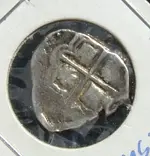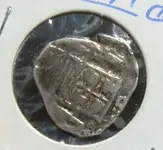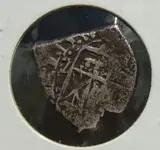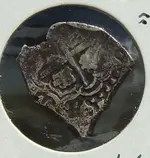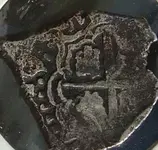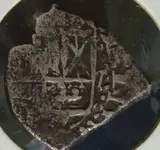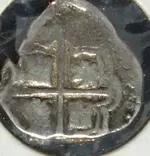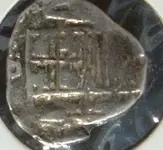You are using an out of date browser. It may not display this or other websites correctly.
You should upgrade or use an alternative browser.
You should upgrade or use an alternative browser.
My two cobs
- Thread starter Road Dog
- Start date
Bigcypresshunter
Sapphire Member
- Joined
- Dec 15, 2004
- Messages
- 27,000
- Reaction score
- 3,340
- Golden Thread
- 0
- Location
- South Florida
- Detector(s) used
- 70's Whites TM Amphibian, HH Pulse, Ace 250
- Primary Interest:
- Beach & Shallow Water Hunting
Ill rotate them to upright and try to compare and study them when I get a chance. So far I ve been 100 percent correct in spotting replicas, counterfeits and fakes just from looking at the pictures but I am no expert.
Bigcypresshunter
Sapphire Member
- Joined
- Dec 15, 2004
- Messages
- 27,000
- Reaction score
- 3,340
- Golden Thread
- 0
- Location
- South Florida
- Detector(s) used
- 70's Whites TM Amphibian, HH Pulse, Ace 250
- Primary Interest:
- Beach & Shallow Water Hunting
Ill have to study these another time because I need to go to work.
aquanut
Bronze Member
- Joined
- Jul 12, 2005
- Messages
- 2,162
- Reaction score
- 1,579
- Golden Thread
- 0
- Location
- Sebastian, Florida
- Detector(s) used
- Fisher CZ21, Tesoro Tiger Shark
This is just a suggestion... but with everyone concerned about fakes, we know that the silver used by the Spaniards was 99.9% pure. They don't have that kind of purity today. Will a specific gravity test reveal the purity?
Aquanut
By the way Big, are you coming to the cook out or not?
Aquanut
By the way Big, are you coming to the cook out or not?
Bigcypresshunter
Sapphire Member
- Joined
- Dec 15, 2004
- Messages
- 27,000
- Reaction score
- 3,340
- Golden Thread
- 0
- Location
- South Florida
- Detector(s) used
- 70's Whites TM Amphibian, HH Pulse, Ace 250
- Primary Interest:
- Beach & Shallow Water Hunting
Im in Ocala on a very slow connection. Of course I will go to the cookout. When is it? I didnt hear anything.
divewrecks
Bronze Member
- Joined
- Sep 7, 2004
- Messages
- 1,038
- Reaction score
- 26
- Golden Thread
- 0
- Location
- Down South - Marietta, GA
- Detector(s) used
- Minelab Explorer SE (land), Aquapulse AQ1B (sea), Fisher CZ-20 (water, beach), Fisher 1266X (woods)
aquanut said:This is just a suggestion... but with everyone concerned about fakes, we know that the silver used by the Spaniards was 99.9% pure. They don't have that kind of purity today. Will a specific gravity test reveal the purity?
Aquanut
Hey Aquanut, silver bullion coins that are 99.9% silver (0.999 pure) are fairly common. Search on Ebay and you will get thousands of hits. Also, the silver in colonial coins was closer in purity to sterling than pure silver, so a forger could melt down flatware and get a purity that would pass as a cob.
Stan
Cob coins were either 93.1% or 91.7% fine depending on the period.
Edit: Of course, in those years of debasement, the fineness was further reduced.
Don...
Edit: Of course, in those years of debasement, the fineness was further reduced.
Don...
divewrecks
Bronze Member
- Joined
- Sep 7, 2004
- Messages
- 1,038
- Reaction score
- 26
- Golden Thread
- 0
- Location
- Down South - Marietta, GA
- Detector(s) used
- Minelab Explorer SE (land), Aquapulse AQ1B (sea), Fisher CZ-20 (water, beach), Fisher 1266X (woods)
Mackaydon said:Cob coins were either 93.1% or 91.7% fine depending on the period.
And with sterling being 92.5% it is very close to either one.
Stan
aquanut
Bronze Member
- Joined
- Jul 12, 2005
- Messages
- 2,162
- Reaction score
- 1,579
- Golden Thread
- 0
- Location
- Sebastian, Florida
- Detector(s) used
- Fisher CZ21, Tesoro Tiger Shark
Hey Big, check out the topic "Spanish Galleons" under the Shipwreck Thread. What started as an idea seems to have developed into a cookout and meeting at my house May23rd in Orlando. All the details are there.
To Everbody, Thanks for the info on my Silver content Question.
Aquanut
To Everbody, Thanks for the info on my Silver content Question.
Aquanut
Bigcypresshunter
Sapphire Member
- Joined
- Dec 15, 2004
- Messages
- 27,000
- Reaction score
- 3,340
- Golden Thread
- 0
- Location
- South Florida
- Detector(s) used
- 70's Whites TM Amphibian, HH Pulse, Ace 250
- Primary Interest:
- Beach & Shallow Water Hunting
Ill check it out Aquanut, thanks.
Bigcypresshunter
Sapphire Member
- Joined
- Dec 15, 2004
- Messages
- 27,000
- Reaction score
- 3,340
- Golden Thread
- 0
- Location
- South Florida
- Detector(s) used
- 70's Whites TM Amphibian, HH Pulse, Ace 250
- Primary Interest:
- Beach & Shallow Water Hunting
Bigcypresshunter
Sapphire Member
- Joined
- Dec 15, 2004
- Messages
- 27,000
- Reaction score
- 3,340
- Golden Thread
- 0
- Location
- South Florida
- Detector(s) used
- 70's Whites TM Amphibian, HH Pulse, Ace 250
- Primary Interest:
- Beach & Shallow Water Hunting
BCH:
Sure, I'll comment.
I stay out of the 'real' or 'fake' opinion regarding coins, especially cob coins, not because I have little or no knowledge of them, but because I am not an expert nor do I have enough facts.
Of course, if the shield has 3 castles and one lion or the other way around, the 'red flag' flies. And if the coin is overweight, I am suspicious. But if the coin is underweight, no problem. If the coin contains greater fineness than required, I am suspicious; but that is not conclusive since some Potosi coins were 94% fine. And if the coin is less fine than required, that can be no problem, per se. (Potosi coins got down to 79% pure-alloyed with copper, iron or other 'impurities'.) If the coin is 'botched' in many ways, I have no problem--like the recent example of 'flat waves' under a 'waves and columns' coin; no problem. That 'irregularity' occurred naturally in the minting process.
Also, viewing an encapsulated coin or an out of focus coin pic or a viewing a coin's surface distorted by reflecting glare--or other challenges to determining if the coin is real or not--keeps me out of that 'real or fake' arena.
On the other hand, ID--ing a coin as to its age, determining the monarch, chatting about the circumstances surrounding the coin (concurrent with the coin's date events, etc.) and discussing the knowledge that can be learned from the piece (real or fake) is were added value (and my increased attention) exists.
Don........
Sure, I'll comment.
I stay out of the 'real' or 'fake' opinion regarding coins, especially cob coins, not because I have little or no knowledge of them, but because I am not an expert nor do I have enough facts.
Of course, if the shield has 3 castles and one lion or the other way around, the 'red flag' flies. And if the coin is overweight, I am suspicious. But if the coin is underweight, no problem. If the coin contains greater fineness than required, I am suspicious; but that is not conclusive since some Potosi coins were 94% fine. And if the coin is less fine than required, that can be no problem, per se. (Potosi coins got down to 79% pure-alloyed with copper, iron or other 'impurities'.) If the coin is 'botched' in many ways, I have no problem--like the recent example of 'flat waves' under a 'waves and columns' coin; no problem. That 'irregularity' occurred naturally in the minting process.
Also, viewing an encapsulated coin or an out of focus coin pic or a viewing a coin's surface distorted by reflecting glare--or other challenges to determining if the coin is real or not--keeps me out of that 'real or fake' arena.
On the other hand, ID--ing a coin as to its age, determining the monarch, chatting about the circumstances surrounding the coin (concurrent with the coin's date events, etc.) and discussing the knowledge that can be learned from the piece (real or fake) is were added value (and my increased attention) exists.
Don........
Bigcypresshunter
Sapphire Member
- Joined
- Dec 15, 2004
- Messages
- 27,000
- Reaction score
- 3,340
- Golden Thread
- 0
- Location
- South Florida
- Detector(s) used
- 70's Whites TM Amphibian, HH Pulse, Ace 250
- Primary Interest:
- Beach & Shallow Water Hunting
OK thanks. But all of that IDing is kinda irrevelant on a fake coin. I think its of utmost importance to determine the authenticity. Fakes, replicas and counterfeits are showing up everywhere in an alarming rate and Im sure our readers need to know authenticity information as well. I know you are very knowlegable with coins and I understand you're not wanting to comment if you're not sure. I was hoping you could help. 8)Mackaydon said:On the other hand, ID--ing a coin as to its age, determining the monarch, chatting about the circumstances surrounding the coin (concurrent with the coin's date events, etc.) and discussing the knowledge that can be learned from the piece (real or fake) is were added value (and my increased attention) exists.
Don........
Anyone else?
Bigcypresshunter
Sapphire Member
- Joined
- Dec 15, 2004
- Messages
- 27,000
- Reaction score
- 3,340
- Golden Thread
- 0
- Location
- South Florida
- Detector(s) used
- 70's Whites TM Amphibian, HH Pulse, Ace 250
- Primary Interest:
- Beach & Shallow Water Hunting
Thanks for the tip on the waves. The flat waves do appear on the Lima cobs, but the waves on the recent cob you speak of that I IDed as fake just didnt look right at all. It had way too many other issues and Sedwick had no hesitation giving his opinion from the pic as a crude fake. http://forum.treasurenet.com/index.php/topic,228193.0.htmlMackaydon said:If the coin is 'botched' in many ways, I have no problem--like the recent example of 'flat waves' under a 'waves and columns' coin; no problem. That 'irregularity' occurred naturally in the minting process.
If we cant help you here at TN, Road Dog, you could send your pics to Sedwick. But I think you will get some other comments here. Be patient. Most members are hesitant to call a cob fake and thats certainly understandable.
BCH:
IMO it is unfortunate that you seem to believe that a piece is 'relevant' only if it is real. Granted, 'authenticity' is required in determining monetary value. But monetary value is only one aspect of a coin's total value. For example, IMO, teaching a child the story behind a coin, letting him hold what he might think is a ''real' piece of history and watching the kid 'glow' with a handful of replica coins pullled out of a (fake) satin pouch, should far outweighs knowing the coin is real, it's condition is (say) VF-40, it's encapsulated by a reputable company or it's retail value is (say) $17. What is the relevancy of all that to the kid or to one who is enjoying watching the kid playing with the replica?
Don.........
IMO it is unfortunate that you seem to believe that a piece is 'relevant' only if it is real. Granted, 'authenticity' is required in determining monetary value. But monetary value is only one aspect of a coin's total value. For example, IMO, teaching a child the story behind a coin, letting him hold what he might think is a ''real' piece of history and watching the kid 'glow' with a handful of replica coins pullled out of a (fake) satin pouch, should far outweighs knowing the coin is real, it's condition is (say) VF-40, it's encapsulated by a reputable company or it's retail value is (say) $17. What is the relevancy of all that to the kid or to one who is enjoying watching the kid playing with the replica?
Don.........
Bigcypresshunter
Sapphire Member
- Joined
- Dec 15, 2004
- Messages
- 27,000
- Reaction score
- 3,340
- Golden Thread
- 0
- Location
- South Florida
- Detector(s) used
- 70's Whites TM Amphibian, HH Pulse, Ace 250
- Primary Interest:
- Beach & Shallow Water Hunting
OK I understand. np. Can you ID these? Its just that often it is a fantasy piece and not an exact replica. Like I said in the other post I collect pictures of replicas, counterfeits, and fakes. Often these counterfeiters make mistakes and no such cob exists. Also many members here buy on eBay and pay hard earned money for a silver fake. I just thought Road Dog would like to know. Maybe he doesnt care if its a fake and maybe I am out of line.Mackaydon said:BCH:
IMO it is unfortunate that you seem to believe that a piece is 'relevant' only if it is real. Granted, 'authenticity' is required in determining monetary value. But monetary value is only one aspect of a coin's total value. For example, IMO, teaching a child the story behind a coin, letting him hold what he might think is a ''real' piece of history and watching the kid 'glow' with a handful of replica coins pullled out of a (fake) satin pouch, should far outweighs knowing the coin is real, it's condition is (say) VF-40, it's encapsulated by a reputable company or it's retail value is (say) $17. What is the relevancy of all that to the kid or to one who is enjoying watching the kid playing with the replica?
Don.........
BCH:
The first thing I noted was on the second coin. The upper right panel of the shield shows an "X" with ONLY ONE verticle line--and that reminded me of coins produced in Cartegena, Colombia. Check out the shield in Sedwick's 3rd edition, top left on page 108. I'll give it some more time later.
Don....
The first thing I noted was on the second coin. The upper right panel of the shield shows an "X" with ONLY ONE verticle line--and that reminded me of coins produced in Cartegena, Colombia. Check out the shield in Sedwick's 3rd edition, top left on page 108. I'll give it some more time later.
Don....
Similar threads
Users who are viewing this thread
Total: 1 (members: 0, guests: 1)



